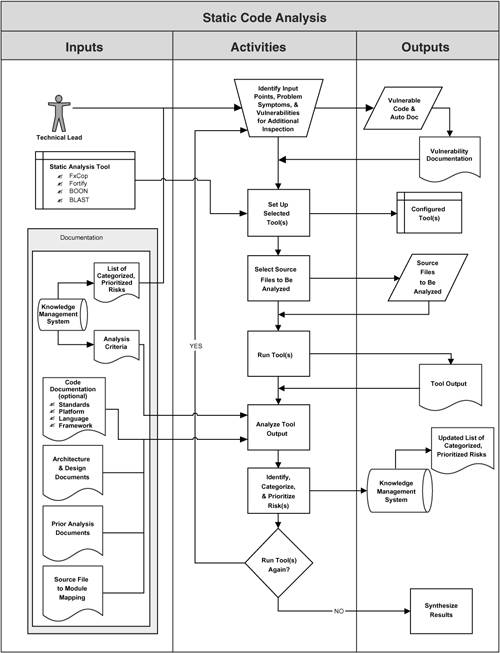Touchpoint Process: Code Review
| I am not a process person, especially when it comes to software. But there is no denying that complex tools like those described in this chapter can't simply be thrown at the software security problem and expected to solve problems willy-nilly. By wrapping a tool like the Fortify SCA Engine in a process, your organization can benefit much more from tool use than if you buy the tool and stick it on a shelf. Figure 4-7 shows a very simple process for applying a static analysis. Note that this is only one of many processes that can be wrapped around a source code analysis tool. The process here is very much based on a software assurance perspective and is the kind of process that a software security type or an analyst would use. There are other use cases for developers (e.g., more closely aligned with IDE integration). This process is one of many. Figure 4-7. A simple process diagram showing the use of a static analysis tool. This is a simplified version of the process used by Cigital. Static code analysis can be carried out by any kind of technical resource. Background in software security and lots of knowledge about software security bugs is very helpful because the tool identifies particular areas of the code for the analyst to check more thoroughly. The tool is really an analyst aid more than anything. The analyst can choose from any number of security tools (as shown in Figure 4-7), including, in some cases, use of research prototypes. The analyst uses a tool on the code to be analyzed and both refers to external information regarding potential problems and tracks issues that are identified. Note that raw tool results are not always the most useful form of information that this process can provide. As an analyst pours over results, some possible problems will turn out to be non-issues. Other possible problems will turn out to be exploitable. Figuring this all out is the bulk of the work when using a source code analysis tool. The simple process shown in Figure 4-7 results in code that has been fully diagnosed and a set of issues that need to be addressed. Fixing the code itself is not part of this process. A much different approach can be taken by developers who can use a tool to spot potential problems and then fix them as they work. This is probably the most effective use of static analysis technology. Even so, widespread adoption of source code analysis tools by development shops is only now beginning to happen. |
EAN: 2147483647
Pages: 154